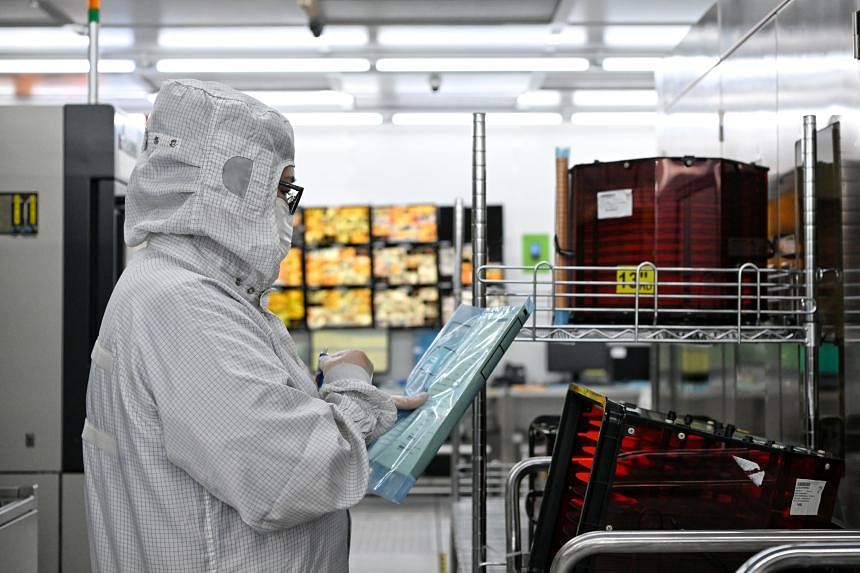SINGAPORE – Singapore’s manufacturing output rose by 1.1 per cent year on year in January, undershooting analysts’ expectations for a 3.7 per cent expansion, as the key electronics sector retreated.
Excluding biomedical manufacturing, manufacturing output expanded by 5.4 per cent and, separately, December’s overall 2.5 per cent contraction was revised marginally lower to 2.4 per cent, according to statistics released by the Economic Development Board on Feb 26.
Among the electronics segments, only infocommunications and consumer electronics registered an expansion, posting a 23.8 per cent jump. It was not enough to overturn the overall 3.4 per cent decline in the sector.
The semiconductors segment, which accounts for the bulk of Singapore’s electronics output, slid 3.4 per cent; computer peripherals and data storage fell 20.1 per cent; and other electronic modules and components saw a 9.5 per cent decline.
Overall, the electronics sector accounts for 45 per cent of Singapore’s total manufacturing production.
Also dragging the manufacturing sector lower was the biomedical sector, as it dropped by 25.9 per cent on a year-on-year basis, largely on the back of a 43.7 per cent fall in pharmaceuticals amid a change in the mix of active pharmaceutical ingredients being produced from a year ago.
Bright spots in the data included transport engineering, which grew by 43.5 per cent, boosted by a 69.1 per cent spike in the aerospace segment, although this was due largely to a low base a year ago resulting from component shortages.
The marine and offshore engineering segment grew 27.6 per cent, supported by higher shipyard activity, as well as more oil and gas equipment produced.
Also providing a boost was the precision engineering sector, as output expanded by 27.7 per cent. This was largely due to the machinery and systems segment, which surged by 33.3 per cent, aided by the higher output of front-end semiconductor equipment and process control equipment.
But the boosts fell short of fuelling January’s output rise to the 3.7 per cent increase forecast by analysts in a Bloomberg poll.
Commenting on the data, both OCBC Bank chief economist Selena Ling and Maybank Research regional co-head of macro research Chua Hak Bin felt that the volatile January data was to be expected, given that the Chinese New Year holidays can fall anywhere between January and February, depending on the year.
Dr Chua also pointed to the severity of winter conditions in major markets, such as the United States and China, as a probable cause for the variance, along with delays and longer shipping times due to the Red Sea crisis and drought in the Panama Canal.
Ms Ling said: “I wouldn’t read too much into this one month’s worth of data – if the industrial production level can sustain anywhere close to January levels, then February growth shouldn’t look so depressed.”
Both experts suggested that a better gauge of the overall strength and momentum of the manufacturing recovery may be to average the data for January and February.
Looking ahead, DBS Bank economist Chua Han Teng said the January expansion marked a good start to 2024 for Singapore manufacturers.
“We expect better manufacturing prospects in 2024, following 2023’s full-year contraction,” he said, but noted that this will hinge on the electronics cluster’s performance.
“We see signs of improving electronics demand from rising new orders, new export orders, and accumulating backlog orders registered in Singapore’s electronics purchasing managers’ index for January 2024.”
He felt that such a recovery in manufacturing is likely to be gradual and fragile as the “global economic environment remains uncertain, due to high interest rates in advanced economies, bumpy conditions in China, and lingering geopolitical tensions that could still disrupt supply chains”.
Ms Ling was somewhat more optimistic. “Industrial production should gradually improve for the remaining quarters of this year to average around 2 per cent for 2024. The fact that precision engineering has been improving, and it is part of the electronics ecosystem, suggests there’s no need to be too bearish,” she said.
Maybank’s Dr Chua said that despite the manufacturing recovery proving to be more of a hard slog than a strong rebound, “we maintain our view that GDP (gross domestic product) growth will climb to 2.2 per cent in 2024”.
“This will be led by a modest manufacturing recovery as momentum picks up more decisively in the second half of the year.”


